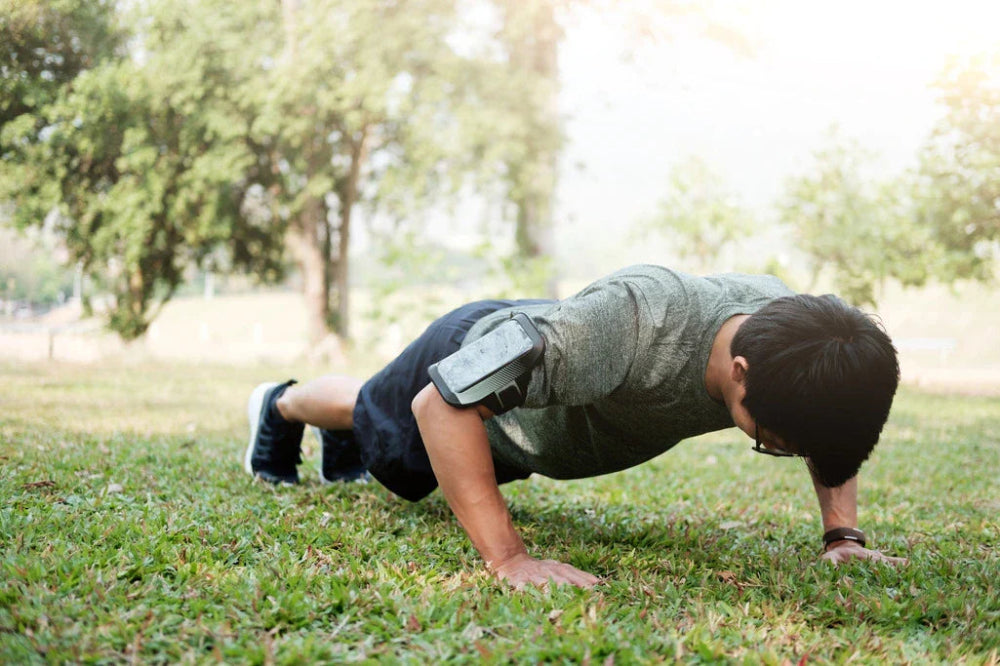You drop down for push-ups, ready to crush your set, and boom, your wrists light up with pain.
Not the good kind of “I’m working hard” pain, but the annoying, sharp kind that makes you want to quit halfway through. Sound familiar?
Wrist pain during push-ups is super common, and it’s usually not your fault.
The good news? It’s fixable (without fancy gear, surgery, or giving up push-ups altogether).
Today, we’re going to break it all down.
Why your wrists are hurting, what’s causing the pressure, and what simple tweaks you can make today to stop the pain and get back to building strength, without wrecking your joints.
Let’s get you back to pain-free push-ups, starting now.
What’s Really Causing Your Wrist Pain During Push-Ups?
 Let’s be real that wrist pain isn’t random. There are a few common reasons behind it.
Let’s be real that wrist pain isn’t random. There are a few common reasons behind it.
Once you figure out which one applies to you, fixing it becomes easier.
1. Limited Wrist Mobility
Most people don’t spend time stretching or moving their wrists daily. That means the joint becomes stiff and lacks the extension needed for push-ups (the ability to bend your wrist back at a 90-degree angle).
When you force your wrists into this position without mobility, pain shows up fast.
If your wrist feels tight or stiff just placing your hands flat on the floor, you likely have mobility issues.
2. Improper Hand Positioning
Where your hands go during push-ups matters.
Many people place their hands too far forward or let their elbows flare out, which shifts more pressure into the wrists than the muscles.
- Hands should be just under your shoulders
- Fingers spread wide for weight distribution
- Palms grounded, not just the heel of the hand
Bad form = more pressure on your joints than your muscles.
3. Weak Wrist and Forearm Muscles
Your wrists aren’t just bones, they're supported by tendons, ligaments, and muscles.
If your wrist stabilizers are weak (which they often are from a lot of typing and little movement), they can’t hold up during push-ups. That leads to discomfort, fatigue, and eventually pain.
4. Previous Injuries or Conditions
If you’ve had wrist sprains, carpal tunnel, or a TFCC tear, push-ups can aggravate those conditions.
Any time you load weight onto an already vulnerable area, pain is going to show up. You’ll need a more strategic approach and possibly a different variation.
How to Stop Wrist Pain During Push-Ups (Step-by-Step Fixes)
Now that you know what’s causing the problem, here’s how to solve it.
These fixes work for most people and can save your wrists from long-term damage.
1. Improve Your Wrist Mobility
Try these daily wrist mobility drills before push-ups:
- Wrist Circles: Rotate your wrists slowly in both directions (10 reps each).
- Wrist Extension Stretch: On hands and knees, fingers facing forward, slowly rock your weight forward and backward.
- Prayer Stretch: Place palms together in front of chest and slowly lower hands to stretch the wrists.
Even 5 minutes of these a day makes a difference in 2–3 weeks.
2. Strengthen Your Forearms & Wrist Stabilizers
Add these exercises to your routine 2–3x per week:
- Wrist curls and reverse curls (use light dumbbells or resistance bands)
- Farmer’s carry (hold heavy weights at your sides and walk)
- Gripzilla Hand Gripper or towel squeeze for grip strength
3. Fix Your Form (Small Changes, Big Impact)
Here’s how to align your push-up position for less wrist pressure:
- Place hands directly under shoulders, not ahead.
- Keep elbows tucked (about a 45° angle).
- Distribute weight across the entire hand, especially through your fingers and the base of your knuckles.
- Engage your core and glutes so you don’t sag, which increases wrist load.
A mirror or video can help you see what needs adjusting.
4. Try Push-Up Variations That Reduce Wrist Pressure
You don’t need to stop doing push-ups. Just modify them for comfort:
- Fist/knuckle push-ups: Keep wrists in a neutral position
- Push-ups on dumbbells or push-up bars: These tools keep wrists straight and reduce strain
- Incline push-ups: Hands on a bench or box to reduce angle and pressure
Choose the variation that feels best while still challenging your muscles.
When Should You See a Doctor?
If your wrist pain:
- Doesn’t improve even after rest and adjustments
- Comes with numbness, tingling, or swelling
- Is sharp or shooting during any movement
It’s time to consult a doctor or physiotherapist. You may be dealing with an injury that needs specific care (like carpal tunnel or tendonitis).
Don’t Let Wrist Pain Kill Your Progress
Wrist pain during push-ups is common, but it’s not something you have to live with.
A few small changes to your routine, some mobility work, wrist strengthening tools, and proper push-up form can make a world of difference.
Think of it this way: if your wrists can’t support your strength, how will the rest of your body grow?
Fix the cause now, and push-ups will feel better than ever.



